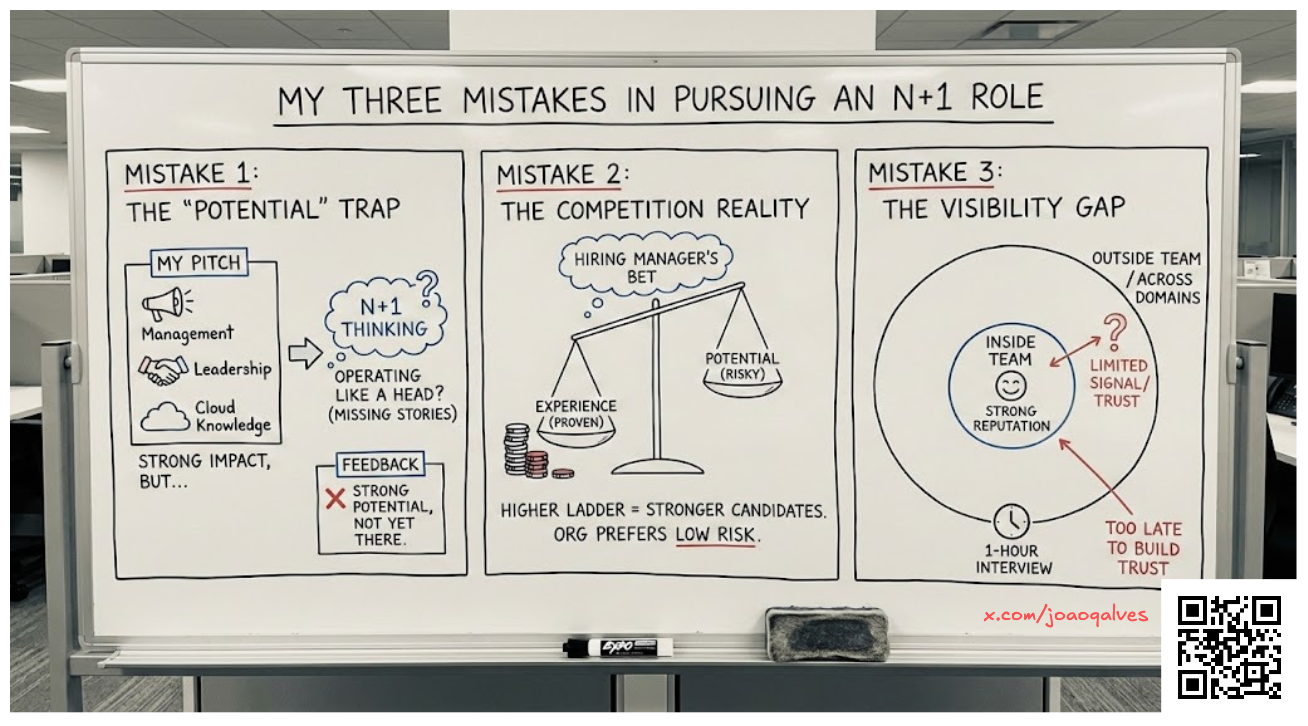Every time we talk about promotions and career paths, we listen a lot about how to get there. Today, I want to tell the story of how I failed to get the role... twice!
For context: I joined Adevinta as Engineering Manager of the Runtime team in late 2020. We were part of an internal Platform-as-a-Service (PaaS) offering. We provided SCHIP, a Kubernetes container runtime.
Fast forward a few years. We onboarded every marketplace of the group. We increased traffic and handled more requests per second in our clusters. We improved how we supported users. We shipped new features. And we helped Adevinta migrate to the Public Cloud on Amazon Web Services (AWS). I was proud of the team. I was proud of the culture we built. I had great feedback from my managers. And I felt I was ready for the next step.
So, when Renaud, the VP of Cloud and Infrastructure, opened a “Head of Cloud Platform” position, I thought: there we go! The process consisted of two 1:1 interviews: one with the VP himself and another with the Product & Tech’s Human Resources Business Partner (HRBP).
Looking back, there were three things I missed:
- I talked about my impact, but not enough about how I already operated at level n+1. My pitch was strong on management, leadership, and Cloud knowledge. But weak on stories that proved I was thinking like a Head. Although my managers delegated “n+1” work to me and I had some sense of what the job entailed, it led to a “strong potential, but not yet there” rating.
- The second one is perhaps obvious, but I’ll say it out loud anyway: the higher you climb the ladder, the stronger the candidates competing against you will be. Most hiring managers will put their chips on experience vs potential. At the end of the day, the whole organization will respond, and it’s not always the best time to place risky bets.
- I didn’t invest early enough in visibility. Inside my team, I had a strong reputation. Outside my team, fewer people had seen me operate. At senior levels, trust does not build in a one-hour interview. You need a signal long before that. I should have connected more, shared more, collaborated more across domains. By the time I realized it, it was too late. Some people think this is politics. And it is. But it’s also reality. If an interviewer has one hour with you and must evaluate several strong candidates, who do you think will be top of mind?
Image generated with Gemini-3/NanoBanana
Promotions in a post-ZIRP world
During the Zero Interest Rate Period (ZIRP) years, promotions were easier to obtain. Companies were growing fast, and teams expanded, growing headcount every year. New products launched. New layers of management appeared. Many careers moved forward because the business kept moving forward.
That time is now over. Interest rates rose, and growth slowed. Engineering organizations became flatter. We can see companies like Amazon trimming manager-heavy structures.
To sum up: fewer roles. Higher expectations. Tougher competition. If you want to grow in this new environment, you need to adapt your strategy. Here are the key shifts to keep in mind:
- Being great at your job is not enough. You need to demonstrate that you already operate at the next level, and make that evidence easy to see. Prepare clear stories with the STAR method that show judgment, cross-team impact, and decisions that look like level n+1 work. Ask your manager for delegation (e.g., volunteer for initiatives that stretch your scope). Build the proof before you need it. And remember: in a slow-growth world, leaders favor experience over potential. You must close that gap by preparing intensely. Some people think the promotion loop is just a waste of time, like an interview. It turns out it is an interview! Bring a crisp 90-day plan. Show how you think. Show how you would lead. Do not rely on “I did a great job.” Rely on proof that you can operate bigger.
- Visibility is a core skill. Treat it as part of the job. Trust at senior levels does not form in a one-hour interview. It forms because people have seen you operate, reason, and collaborate. Make visibility intentional by sharing learnings or writing decision documents. Help teams outside your area. Ask thoughtful questions in cross-org forums. If you walk into a promotion loop with zero pre-existing signal, you will lose to someone who built it over months.
- Leverage matters more than headcount. In the ZIRP era, promotions often came with growing teams. That world changed. Now companies reward leverage:
- the systems you fix
- the cross-team problems you unblock
- the decisions you improve
- the clarity you bring
- the cultural habits you reinforce
Span of control matters less. Measurable impact across boundaries matters more. Start asking: “What work creates the biggest lift for the organization, not just my team?” Then run toward that work.
Before you chase your next promotion
The career ladders for Engineering Managers didn’t disappear. They just got steeper. With the proper preparation, the right stories, and the right visibility, you can still climb them.
I learned these lessons through some painful misses, so you don’t have to. If you want to talk about your own path or need help preparing for a step up, my inbox is always open.
— João
PS: I’m building RotaHog, a lightweight tool for managing team rotation schedules (on-call, support shifts, release duties, etc.). Try it if you’re tired of hacking spreadsheets or Slack threads together. I’d love your feedback!
If you enjoyed this article, consider subscribing to the newsletter and buying me a coffee.
